The difference between a paint with trouble-free performance and failure can depend in large part on the rheology of the paint. Rheology is defined as the science of flow and deformation and influences properties such as:
- Transfer of resin and paint
- Pigment dispersion
- Application (brush, roller, reverse or direct roll coat, spray, disc and flow coat)
- Film formation (flow, leveling and film coalescence)
- Storage stability (resistance to hard settling of pigment)
In contrast, viscosity can be defined as the resistance to flow. A discussion of flow and leveling is meaningless without consideration and understanding of viscosity. Simply stated, viscosity is the resistance of a liquid to flow and can be defined in measurable values. Viscosity is expressed as the relationship between shear stress and shear rate.
ϒ (shear stress) = F (force) / A (area)
D (shear rate) = V (velocity) / C (thickness)
Shear rate is expressed as sec-1 and shear stress as dyne/cm2
Accordingly, viscosity can be expressed as shear stress / shear rate:
η (viscosity) = ϒ (shear stress) / D (shear rate)
It follows that the units of viscosity are dyne/cm2 / sec-1 or dyne-sec / cm2 or poise. Fluids are classified as:
- Newtonian (linear relationship of viscosity with shear rate)
- Thixotropic or pseudoplastic (decrease in viscosity with increasing shear rate)
- Dilatent (increase in viscosity with increasing shear rate)
Table 1. Viscosity units of measurement
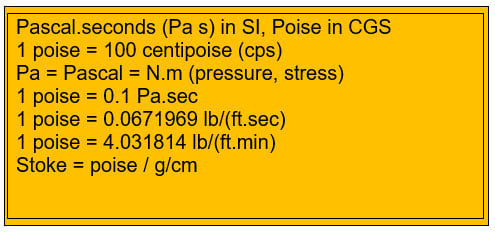
Figure 1. Single point viscosity measurement v. multi-point viscosity measurement
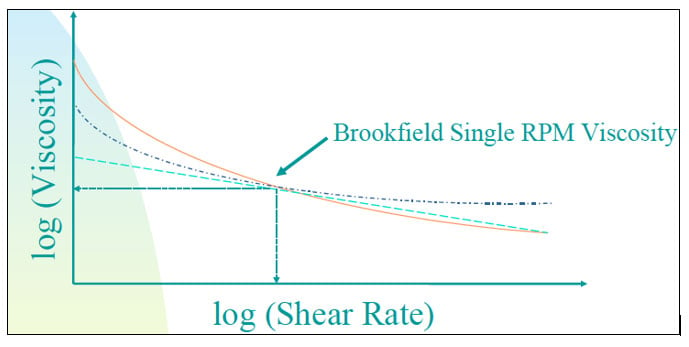
As Figure 1 indicates, a single point viscosity measurement does not provide the information necessary to determine if a paint is Newtonian, dilatant or thixotropic. Accordingly, to properly formulate a paint for various paint processes, it is necessary to know the viscosity characteristics over a range of shear rates. Multi-point viscosity determinations and rheology adjustments enable optimized pigment dispersion, resin and paint transfer, application, paint flow, leveling and storage stability.
Viscosity characteristics of various fluids
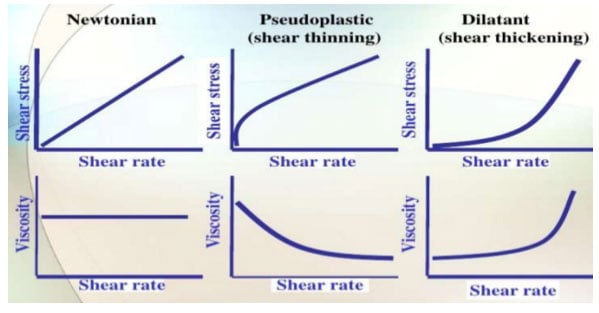
Figure 2. Viscosity and shear rate requirements for various paint processes
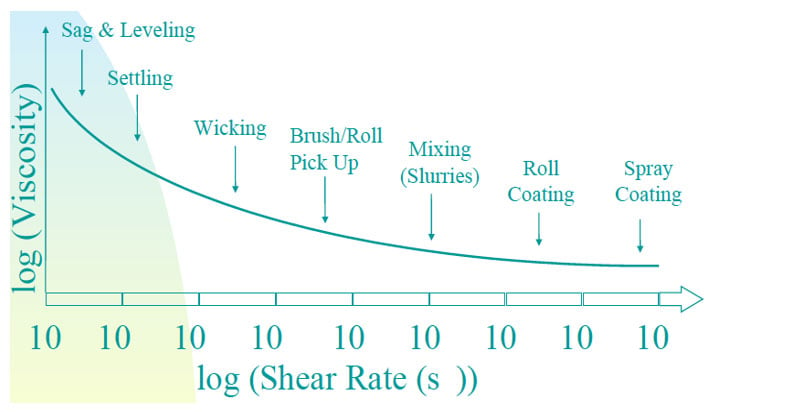
As Figures 3 and 4 illustrate viscosity requirements for coating processes such as resin and paint transfer, pigment dispersion, application, film formation and storage stability are dependent on rheology. For example, in high speed pigment dispersion and application properties, a degree of thixotropy (shear thinning) aids processing, sag resistance and settling resistance.
Fig. 3 Type of viscosity determinations for various processes
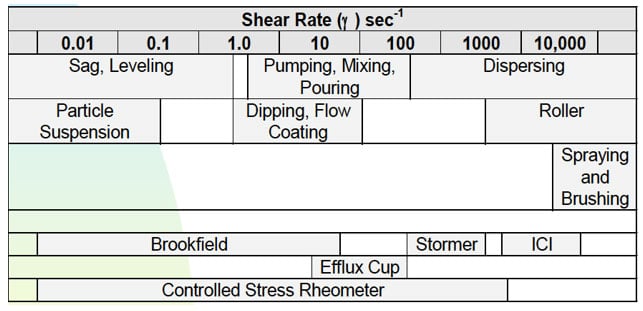
Fig. 4 Rheology profile for multiple paint processes
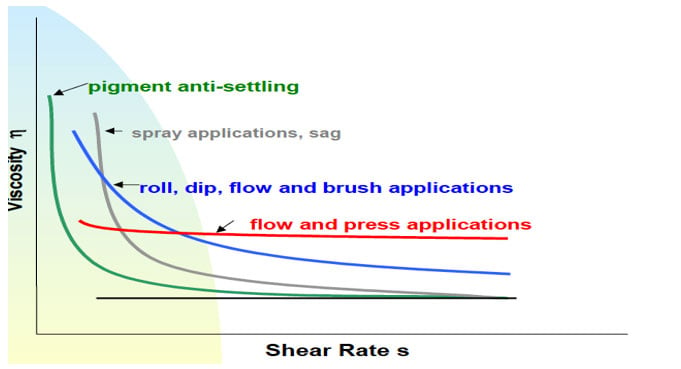
Fig. 5 Viscosity requirements for mill base formulation
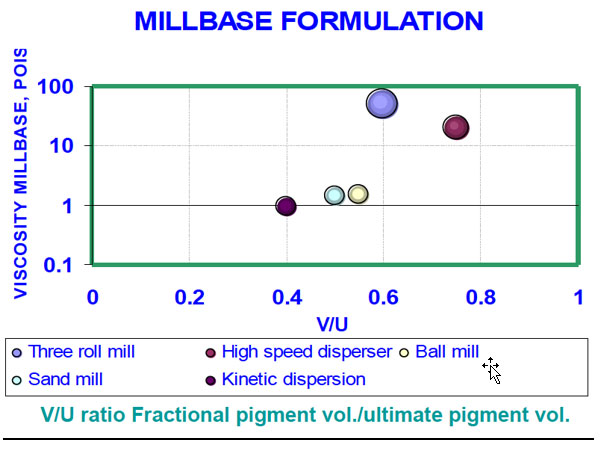
Multiple rheology/control modifiers can be found using the Prospector Search Engine and are available to modify waterborne and solvent-borne paints to adjust application properties as well as for resistance to hard setting. There are multiple ingredients and variables that influence rheology in a coating formulation.
The issues that impact rheology in paints include:
- Coating ingredients
- Binders (solution versus latex or dispersion)
- Pigments
- Filler pigments and extenders
- Pigment dispersants
- Surfactants
- Amines amount and type (waterborne paints)
- pH (waterborne)
- Cosolvent
- Customization of rheological properties
- Criteria for rheology modification and selection
- Flow and leveling agents
- Surfactants
- Other additives
The viscosity of latex paints tends to exhibit excessive shear thinning behavior and is dependent on multiple compositional factors as listed above. For latex paints, when the viscosity at high shear rates is adjusted for proper application, the viscosity at low shear rates for proper leveling tends to be high. This is the reason why the leveling of latex paints tends to be poorer than that of solvent-borne paints. This is most pronounced at higher gloss levels. Accordingly, to counteract this phenomena, associative thickeners are used. In simple terminology, associative thickeners can be defined as a water-soluble polymer containing multiple hydrophobic groups.
Some common thixatropes and their incorporation include:
- Organo clay – Added during pigment dispersion step
- Hydrogenated castor wax – Added to mill base while cooling/heat activated
- Polyamide – Added to mill base while cooling/heat activated or can be preactivated and added during letdown
- Fumed silica – Added during letdown
Rheology control agents for waterborne coatings include:
- Cellulosics
- Hydroxyethyl cellulose
- Carboxyl functional cellulose
- Methyl cellulose
- Polyamides
- Synthetic clay
- Colloidal silica
Associative thickeners types for waterborne coatings include:
- HEUR (Hydrophobically Modified Ethoxylated Urethanes)
- HASE (Hydrophobically-Modified Alkali-Swellable Emulsions)
- HMEC (Hydrophobically-Modified Hydroxy Ethyl Cellulose)
- HEURASE – Hydrophobically Modified Ethoxylated Urethane Alkali Swellable Emulsion)
Fig. 6 ASTM D2801 Sag Resistance- Images of applied paint before (left photo) and after (right photo) the addition of a rheology modifier
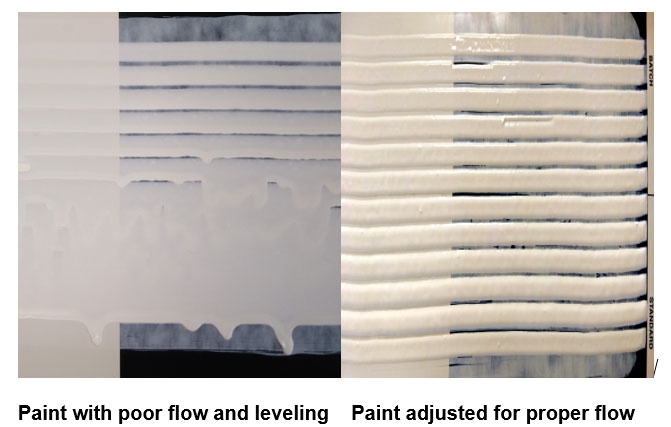
Figure 6. Illustrates the difference in vertical sag resistance of the same paint with (right photo) paint properly adjusted with a thixatrope compared to the photo on the left prior to modification. In summary rheology plays a major role in providing a paint that offers ease of pigment dispersion, good fluid transfer, acceptable application properties and long term resistance to hard settling. Additional information concerning rheological materials can be found using Prospector’s search engine for key words such as rheology, thixotropy, flow and thickener.
Resources
Prospector Knowledge Center and Search Engine
Wikepedia
Organic Coatings, Science and Technology, Third Edition, Wiley, Wicks e.al. 2007
Organic Coatings, Science and Technology, Third Edition, Wiley, Jones e.al. 2017
www.warnerblank.com
